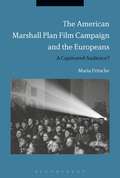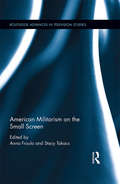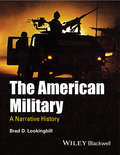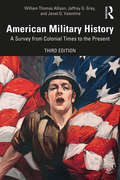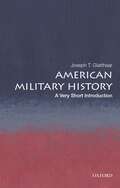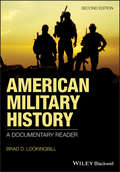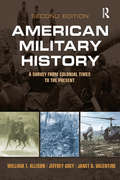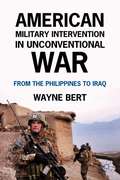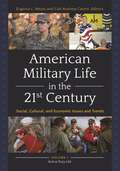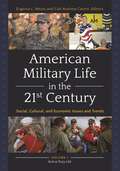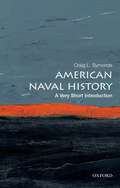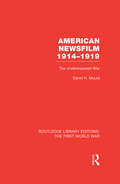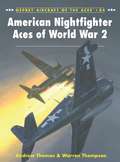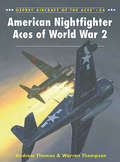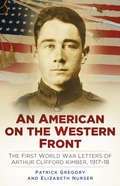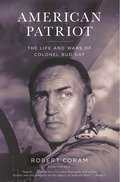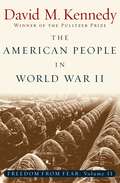- Table View
- List View
The American Marshall Plan Film Campaign and the Europeans: A Captivated Audience?
by Maria FritscheThe US government launched the European Recovery Programme, otherwise known as the 'Marshall Plan', in order to save war-torn Europe from collapse in 1948. Yet while much is known about the economic side of the Marshall Plan, the extensive film campaign that accompanied it has been largely overlooked until now. The American Marshall Plan Film Campaign and the Europeans is the first book to explore the use of the Marshall Plan films and, importantly, their distribution and reception across Europe. The study examines every available film – the 170 that remain from the 200 estimated to have been made – and looks at how they were designed to instil hope, argue the case for economic restructuring and persuade the Europeans of the superiority of the liberal-capitalist system. The book goes on to reason that the films served as a powerful weapon in the cultural Cold War, but that the European audiences were by no means passive victims of the US propaganda effort. Maria Fritsche discusses the Marshall Plan films in the context of countries across Western, Northern and Southern Europe, covering the majority of the 17 European countries that participated in the Plan in the process. The book incorporates 70 images and utilises a vast number of archival sources to explore the strategies the US adopted to sway the minds of the Europeans, the problems they encountered in the process and, not least, the varied responses of the European audiences. It is a vital study for any scholar or student keen to know more about postwar recovery in Europe, the legacy of the Second World War or America's relationship with Europe in the 20th century.
American Militarism on the Small Screen (Routledge Advances in Television Studies)
by Anna Froula Stacy TakacsAnna Froula is Associate Professor of Film Studies in the Department of English at East Carolina University, USA Stacy Takacs is Associate Professor and Director of American Studies at Oklahoma State University, USA
American Militarism on the Small Screen (Routledge Advances in Television Studies)
by Anna Froula Stacy TakacsAnna Froula is Associate Professor of Film Studies in the Department of English at East Carolina University, USA Stacy Takacs is Associate Professor and Director of American Studies at Oklahoma State University, USA
The American Military: A Narrative History
by Brad D. LookingbillThe American Military: A Narrative History presents a comprehensive introduction to more than four centuries of American military history. Presents a chronological account of American military history from clashes between militias and Native Americans to 21st-century operations in Afghanistan and Iraq Features personal vignettes to put a human face on armed conflict Addresses patterns of national service, the evolution of civil-military relations, and the advent of all-volunteer forces Puts events in historical context, and considers cultural, social, political, economic, and technological developments
The American Military: A Narrative History
by Brad D. LookingbillThe American Military: A Narrative History presents a comprehensive introduction to more than four centuries of American military history. Presents a chronological account of American military history from clashes between militias and Native Americans to 21st-century operations in Afghanistan and Iraq Features personal vignettes to put a human face on armed conflict Addresses patterns of national service, the evolution of civil-military relations, and the advent of all-volunteer forces Puts events in historical context, and considers cultural, social, political, economic, and technological developments
American Military History: A Survey From Colonial Times to the Present
by William Thomas Allison Jeffrey G. Grey Janet G. ValentineNow in its third edition, American Military History examines how a country shaped by race, ethnicity, economy, regionalism, and power has been equally influenced by war and the struggle to define the role of a military in a free and democratic society. Organized chronologically, the text begins at the point of European conflict with Native Americans and concludes with military affairs in the early 21st century, providing an important overview of the military’s role on an international, domestic, social, and symbolic level. The third edition is fully updated to reflect recent developments in military policy and the study of military history and war and society, thus providing students a foundational understanding of the American military experience. This book will be of interest to students of American history and military history. It is designed to allow instructors flexibility in structuring a course.
American Military History: A Survey From Colonial Times to the Present
by William Thomas Allison Jeffrey G. Grey Janet G. ValentineNow in its third edition, American Military History examines how a country shaped by race, ethnicity, economy, regionalism, and power has been equally influenced by war and the struggle to define the role of a military in a free and democratic society. Organized chronologically, the text begins at the point of European conflict with Native Americans and concludes with military affairs in the early 21st century, providing an important overview of the military’s role on an international, domestic, social, and symbolic level. The third edition is fully updated to reflect recent developments in military policy and the study of military history and war and society, thus providing students a foundational understanding of the American military experience. This book will be of interest to students of American history and military history. It is designed to allow instructors flexibility in structuring a course.
American Military History: A Very Short Introduction (Very Short Introductions)
by Joseph T. GlatthaarSince the first English settlers landed at Jamestown with the legacy of centuries of European warfare in tow, the military has been an omnipresent part of America. In American Military History: A Very Short Introduction, Joseph T. Glatthaar explores this relationship from its origins in the thirteen colonies to today's ongoing conflicts in the Middle East. During the Revolutionary War, tension grew between local militias and a standing army. The Founding Fathers attempted to strike a balance, enshrining an army, navy, and a "well-regulated Militia" in the Constitution. The US soon witnessed the rise of a professional military, a boon to its successes in the War of 1812, the Mexican War, and the Civil War. However, after the Civil War, the US struggled to learn that the purpose of a peacetime army is to prepare for war. When war did arrive, it arrived with a vengeance, gutting the trenches of the Great War with effective innovations: tanks, planes, machine guns, and poison gas. The US embraced the technology that would win both world wars and change the nature of battle in the Second World War. The US emerged from World War II as the most powerful nation in the war, but over the next several decades it was forced to confront the limits of its power. The nuclear era brought encounters defined by stalemate--from the Cold War conflicts of Korea and Vietnam to the wars in Afghanistan and Iraq. Since 9/11, the US has been frustrated by unconventional warfare, including terrorism and cyberwar, largely negating the technological advantage it had held. Glatthaar examines all these challenges, looking to the future of the U.S. military and its often proud and complicated legacy.
American Military History: A Very Short Introduction (Very Short Introductions)
by Joseph T. GlatthaarSince the first English settlers landed at Jamestown with the legacy of centuries of European warfare in tow, the military has been an omnipresent part of America. In American Military History: A Very Short Introduction, Joseph T. Glatthaar explores this relationship from its origins in the thirteen colonies to today's ongoing conflicts in the Middle East. During the Revolutionary War, tension grew between local militias and a standing army. The Founding Fathers attempted to strike a balance, enshrining an army, navy, and a "well-regulated Militia" in the Constitution. The US soon witnessed the rise of a professional military, a boon to its successes in the War of 1812, the Mexican War, and the Civil War. However, after the Civil War, the US struggled to learn that the purpose of a peacetime army is to prepare for war. When war did arrive, it arrived with a vengeance, gutting the trenches of the Great War with effective innovations: tanks, planes, machine guns, and poison gas. The US embraced the technology that would win both world wars and change the nature of battle in the Second World War. The US emerged from World War II as the most powerful nation in the war, but over the next several decades it was forced to confront the limits of its power. The nuclear era brought encounters defined by stalemate--from the Cold War conflicts of Korea and Vietnam to the wars in Afghanistan and Iraq. Since 9/11, the US has been frustrated by unconventional warfare, including terrorism and cyberwar, largely negating the technological advantage it had held. Glatthaar examines all these challenges, looking to the future of the U.S. military and its often proud and complicated legacy.
American Military History: A Documentary Reader
by Brad D. LookingbillA collection of primary documents that explore the many facets of the American military from the colonial period to the present The second edition of American Military History offers an exceptional collection of primary documents relating to history of the military of the United States from 1607 through the present. The writings offer insight into the armed forces in relation to the social, cultural, economic, political, and territorial development of the United States. Several documents comment on strategic initiatives, combat operations, force structure, public policy, and home fronts. The writings also present firsthand testimony of extraordinary men and women in uniform and most of the documents explore the connections between combatants and the societies that produced them. From the beginnings of the war against the natives through the tragedy of the Civil War and up to the current Global War on Terror, American Military History offers a chronological account of the evolution of the United States military. This vital text: Includes writings that explore the diversity of the armed forces Explores leadership in America’s military affairs Traces America’s ways of war beginning in 1607 through the present Examines the patterns of design and purpose of the American military over time Reveals the vitality of civil-military relations in the United States Written for academics and students of military history, American Military History is an important text that draws on primary sources to explore the many facets of America’s military history.
American Military History: A Documentary Reader
by Brad D. LookingbillA collection of primary documents that explore the many facets of the American military from the colonial period to the present The second edition of American Military History offers an exceptional collection of primary documents relating to history of the military of the United States from 1607 through the present. The writings offer insight into the armed forces in relation to the social, cultural, economic, political, and territorial development of the United States. Several documents comment on strategic initiatives, combat operations, force structure, public policy, and home fronts. The writings also present firsthand testimony of extraordinary men and women in uniform and most of the documents explore the connections between combatants and the societies that produced them. From the beginnings of the war against the natives through the tragedy of the Civil War and up to the current Global War on Terror, American Military History offers a chronological account of the evolution of the United States military. This vital text: Includes writings that explore the diversity of the armed forces Explores leadership in America’s military affairs Traces America’s ways of war beginning in 1607 through the present Examines the patterns of design and purpose of the American military over time Reveals the vitality of civil-military relations in the United States Written for academics and students of military history, American Military History is an important text that draws on primary sources to explore the many facets of America’s military history.
American Military History: A Survey From Colonial Times to the Present
by Janet G. ValentineThis book offers a chronology, subheadings, and terms to provide the reader a pedagogical framework for understanding the central themes and events in the American military experience and their relation to American history. It serves as a foundation for undergraduate courses in military history.
American Military History: A Survey From Colonial Times to the Present
by Janet G. ValentineThis book offers a chronology, subheadings, and terms to provide the reader a pedagogical framework for understanding the central themes and events in the American military experience and their relation to American history. It serves as a foundation for undergraduate courses in military history.
American Military Intervention in Unconventional War: From the Philippines to Iraq
by W. BertA study of the major U.S. military interventions in unconventional war, this book looks at four wars that occurred while the U.S. was a superpower in the post-war WW II period and one in the Philippines in 1898.
American Military Life in the 21st Century [2 volumes]: Social, Cultural, and Economic Issues and Trends [2 volumes]
by Eugenia L. Weiss and Carl Andrew CastroA comprehensive guide to the lives and experiences of military service members, veterans, and their families in the United States today, with special emphasis given to those of the post-9/11 era.This reference work provides detailed information on the issues U.S. service members face both stateside and during deployments overseas. Issues covered include relations with family; substance use; housing; educational and job training opportunities; post-traumatic stress disorder and other health issues; and experiences of women, sexual minorities, and ethnic/racial minorities in the armed services. This set also examines major issues related to military service for people close to the men and women who serve our country, such as spouses or partners, children, and parents grappling with such issues as single parenthood during deployment and bereavement at the loss of a loved one. Finally, this set is a valuable resource for people seeking a greater understanding of the issues that confront some military service members and veterans, from chronic health problems to economic vulnerability to suicide to incarceration. The two volumes are written in a comprehensive yet succinct and accessible style by experts familiar with the latest trends and findings.
American Military Life in the 21st Century [2 volumes]: Social, Cultural, and Economic Issues and Trends [2 volumes]
by Eugenia L. Weiss Carl Andrew CastroA comprehensive guide to the lives and experiences of military service members, veterans, and their families in the United States today, with special emphasis given to those of the post-9/11 era.This reference work provides detailed information on the issues U.S. service members face both stateside and during deployments overseas. Issues covered include relations with family; substance use; housing; educational and job training opportunities; post-traumatic stress disorder and other health issues; and experiences of women, sexual minorities, and ethnic/racial minorities in the armed services. This set also examines major issues related to military service for people close to the men and women who serve our country, such as spouses or partners, children, and parents grappling with such issues as single parenthood during deployment and bereavement at the loss of a loved one. Finally, this set is a valuable resource for people seeking a greater understanding of the issues that confront some military service members and veterans, from chronic health problems to economic vulnerability to suicide to incarceration. The two volumes are written in a comprehensive yet succinct and accessible style by experts familiar with the latest trends and findings.
American Naval History: Five Naval Battles That Shaped American History (Very Short Introductions)
by Craig L. SymondsThis fast-paced narrative charts the history of the US Navy from its birth during the American Revolution through to its current superpower status. The story highlights iconic moments of great drama pivotal to the nation's fortunes: John Paul Jones' attacks on the British during the Revolution, the Barbary Wars, and the arduous conquest of Iwo Jima. American Naval History: A Very Short Introduction illuminates the changes--technological, institutional, and functional--of the U.S. Navy from its days as a small frigate navy through the age of steam and steel to the modern era of electronics and missiles. Renowned naval historian Craig L. Symonds captures the evolving culture of the navy and debates between policymakers about what role the institution should play in world affairs. Internal and external challenges dramatically altered the size and character of the navy, with long periods of quiet inertia alternating with periods of crisis that spurred rapid expansion. The history of the navy reflects the history of the nation as a whole, and its many changes derive in large part from the changing role of the United States itself. ABOUT THE SERIES: The Very Short Introductions series from Oxford University Press contains hundreds of titles in almost every subject area. These pocket-sized books are the perfect way to get ahead in a new subject quickly. Our expert authors combine facts, analysis, perspective, new ideas, and enthusiasm to make interesting and challenging topics highly readable.
American Naval History: A Very Short Introduction (Very Short Introductions)
by Craig L. SymondsThis fast-paced narrative charts the history of the US Navy from its birth during the American Revolution through to its current superpower status. The story highlights iconic moments of great drama pivotal to the nation's fortunes: John Paul Jones' attacks on the British during the Revolution, the Barbary Wars, and the arduous conquest of Iwo Jima. American Naval History: A Very Short Introduction illuminates the changes--technological, institutional, and functional--of the U.S. Navy from its days as a small frigate navy through the age of steam and steel to the modern era of electronics and missiles. Renowned naval historian Craig L. Symonds captures the evolving culture of the navy and debates between policymakers about what role the institution should play in world affairs. Internal and external challenges dramatically altered the size and character of the navy, with long periods of quiet inertia alternating with periods of crisis that spurred rapid expansion. The history of the navy reflects the history of the nation as a whole, and its many changes derive in large part from the changing role of the United States itself. ABOUT THE SERIES: The Very Short Introductions series from Oxford University Press contains hundreds of titles in almost every subject area. These pocket-sized books are the perfect way to get ahead in a new subject quickly. Our expert authors combine facts, analysis, perspective, new ideas, and enthusiasm to make interesting and challenging topics highly readable.
American Newsfilm 1914-1919: The Underexposed War (Routledge Library Editions: The First World War)
by David H. MouldThe First World War was the first conflict in which film became a significant instrument of propaganda. For the United States, the war had two distinct phases: from August 1914 to April 1917, America was officially a neutral country; after April 1917 the United States was in the war, providing men, money and munitions for the Allies. These two phases are mirrored in the newsreels and documentary films shown in the United States. This volume starts by examining the background to the war for the movie industry – the coverage of previous conflicts and the growth of the newsreel. It examines the experiences of American cameramen who worked in the war zone: their efforts to gain access to the front, to overcome problems ranging from unreliable equipment to poor lighting conditions to evading censorship and how this shaped the coverage of the war.
American Newsfilm 1914-1919: The Underexposed War (Routledge Library Editions: The First World War)
by David H. MouldThe First World War was the first conflict in which film became a significant instrument of propaganda. For the United States, the war had two distinct phases: from August 1914 to April 1917, America was officially a neutral country; after April 1917 the United States was in the war, providing men, money and munitions for the Allies. These two phases are mirrored in the newsreels and documentary films shown in the United States. This volume starts by examining the background to the war for the movie industry – the coverage of previous conflicts and the growth of the newsreel. It examines the experiences of American cameramen who worked in the war zone: their efforts to gain access to the front, to overcome problems ranging from unreliable equipment to poor lighting conditions to evading censorship and how this shaped the coverage of the war.
American Nightfighter Aces of World War 2 (Aircraft of the Aces)
by Chris Davey Andrew Thomas Warren Thompson Mark PostlethwaiteThe Americans lagged behind their European contemporaries in military aviation in the late 1930s, and it took the Battle of Britain to awaken America to the necessity of having aircraft that could defend targets against night-time attack by bomber aircraft. This book examines the numerous aircraft types that were used by the US in this role, beginning with the early stop-gap conversions like the TBM Avenger, Lockheed Ventura and the A-20 Havoc (P-70). It goes on to detail the combat history of the newer, radar-equipped Hellcats, Corsairs and Black Widows that were designed to seek out enemy aircraft and which registered most of the kills made by the Navy, Marine Corps and USAAF in 1944–45. With full-colour profiles and rare photographs, this is an absorbing account of an underestimated flying force: the American Nightfighters.
American Nightfighter Aces of World War 2 (Aircraft of the Aces #84)
by Andrew Thomas Mr Chris Davey Mr Mark Postlethwaite Mr Warren ThompsonThe Americans lagged behind their European contemporaries in military aviation in the late 1930s, and it took the Battle of Britain to awaken America to the necessity of having aircraft that could defend targets against night-time attack by bomber aircraft. This book examines the numerous aircraft types that were used by the US in this role, beginning with the early stop-gap conversions like the TBM Avenger, Lockheed Ventura and the A-20 Havoc (P-70). It goes on to detail the combat history of the newer, radar-equipped Hellcats, Corsairs and Black Widows that were designed to seek out enemy aircraft and which registered most of the kills made by the Navy, Marine Corps and USAAF in 1944–45. With full-colour profiles and rare photographs, this is an absorbing account of an underestimated flying force: the American Nightfighters.
An American on the Western Front: The First World War Letters of Arthur Clifford Kimber, 1917-18
by Patrick Gregory Elizabeth NurserThis is the remarkable story of the American First World War serviceman Arthur Clifford Kimber. When his country entered the Great War in 1917, Kimber left Stanford University to carry the first official American flag to the Western Front. Fired by idealism for the French cause, the young student initially acted as a volunteer ambulance driver, before training as a pilot and taking part in dogfights against ‘the Boche’. His letters home give a vivid picture of what Kimber witnessed on his journey from Palo Alto, California to the front in France: keen-eyed descriptions of New York as it prepared for the forthcoming conflict, the privations of wartime Britain and France, and encounters with former president Theodore Roosevelt and Hollywood actress Lillian Gish. Kimber details his exhilaration, his everyday concerns and his horror as he adapts to an active wartime role. Arthur Clifford Kimber was one of the first Americans on the front line after the entry of the US into the war and, tragically, also one of the last to be buried there – killed in action just a few weeks before the end of the war. Here, his frank letters to his mother and brothers, compiled, edited and put in context by Patrick Gregory and Elizabeth Nurser, are published for the first time.
American Patriot: The Life and Wars of Colonel Bud Day
by Robert CoramDuring the course of his military career, Bud Day won every available combat medal, escaped death on no less than seven occasions, and spent 67 months as a POW in the infamous Hanoi Hilton, along with John McCain. Despite sustained torture, Day would not break. He became a hero to POWs everywhere -- a man who fought without pause, not a prisoner of war, but a prisoner at war. Upon his return, passed over for promotion to Brigadier General, Day retired. But years later, with his children grown and a lifetime of service to his country behind him, he would engage in another battle, this one against an opponent he never had expected: his own country. On his side would be the hundreds of thousands of veterans who had fought for America only to be betrayed. And what would happen next would make Bud Day an even greater legend.
The American People in World War II: Freedom from Fear, Part Two (Oxford History of the United States)
by David M. KennedyEven as the New Deal was coping with the Depression, a new menace was developing abroad. Exploiting Germany's own economic burdens, Hitler reached out to the disaffected, turning their aimless discontent into loyal support for his Nazi Party. In Asia, Japan harbored imperial ambitions of its own. The same generation of Americans who battled the Depression eventually had to shoulder arms in another conflict that wreaked worldwide destruction, ushered in the nuclear age, and forever changed their way of life and their country's relationship to the rest of the world. The American People in World War II--the second installment of Kennedy's Pulitzer Prize-winning Freedom from Fear--explains how the nation agonized over its role in the conflict, how it fought the war, why the United States emerged victorious, and why the consequences of victory were sometimes sweet, sometimes ironic. In a compelling narrative, Kennedy analyzes the determinants of American strategy, the painful choices faced by commanders and statesmen, and the agonies inflicted on the millions of ordinary Americans who were compelled to swallow their fears and face battle as best they could. The American People in World War II is a gripping narrative and an invaluable analysis of the trials and victories through which modern America was formed.
